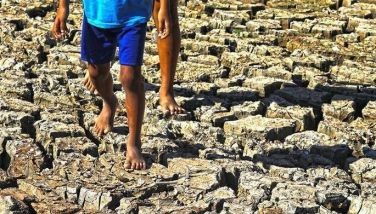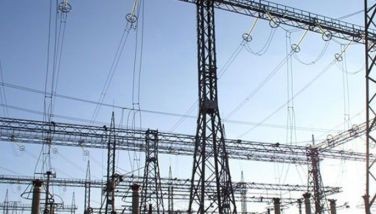Deforestation blamed
December 22, 2003 | 12:00am
For landslides in Leyte
Severe deforestation, days of rain and mountainous terrain triggered landslides that crashed down on several towns in Leyte at the weekend, burying entire villages, an expert said.
Around 200 people were dead or missing after tons of mud slammed into villages near the remote towns of Liloan, Maasin and San Francisco in southern Leyte, and on the northeastern part of Mindanao island, rescuers said.
The mountainous area has been subjected to heavy deforestation which has reduced the water-holding capacity of the land and can make it sloppy, leading to mudslides, government weather forecaster Leny Ruiz told Agence France Presse.
"The area is mountainous, but the main problem there is the mountains have been shorn of trees," he said.
The heavy rains over the past few days could not be described as abnormal for this time of the year, he said, but the dearth of trees had created a dangerous situation.
"Before (the deforestation), there were no problems of flooding or landslides there," Ruiz said.
Heavy logging — much of it illegal — upland migration and agricultural expansion have steadily cut back the Philippines’ forests.
By the late 1980s, forests covered 22 percent, or 6.6 million hectares, of the country from 34 percent in the previous decade, according to the Indonesia-based Center for International Forest Research.
It said most of the degraded areas are mountainous and face "severe erosion problems."
The weather can also pour trouble down on Leyte, which is near the equator and subject to volatile equatorial air systems.
On Nov. 5, 1991, unprecedented massive flash floods descended on the city of Ormoc on northern Leyte, killing nearly 4,000 people and leaving about 50,000 others homeless.
"That one was caused by a thunderstorm concentrated in one area, turning it into a funnel that unleashed sudden flooding," Ruiz said.
An average of 19 storms and typhoons hit the Philippines every year mainly from the Pacific, killing an average of 500 people, official data show.
The 1991 and 2003 Leyte disasters were unique in that they happened outside the typhoon season.
Ruiz said the weather bureau had observed in Leyte weather systems associated with the inter-tropical convergence zone (ICTZ) as well as the edge of a cold front over China when the rains began last week.
The ICTZ phenomenon, which occurs on both sides of the equator, leads to thunderstorms and relatively low surface pressures and causes a strong upward motion of air that is laden with precipitation.
The edge of the cold front, meanwhile, interacts with warmer air from the Pacific, triggering rainfall, Ruiz said.
In the decade that followed the Ormoc disaster, the government built a series of slit dams, the first of their kind in the Philippines, and bridges around the city.
President Arroyo, who unveiled the newly completed first phase two years ago, said the dams were "designed to trap floating logs and debris to prevent them from clogging up the river channels."
The government also built drainage works, hydraulic drops and slope protection structures along the Anilao and Malbasag rivers to protect Ormoc from the floods unleashed by heavy rains.
But these measures have been of little use to the 123 villagers were who still missing and feared dead after the weekend’s landslides, with 77 bodies recovered by an army of rescuers by Sunday. — AFP
Severe deforestation, days of rain and mountainous terrain triggered landslides that crashed down on several towns in Leyte at the weekend, burying entire villages, an expert said.
Around 200 people were dead or missing after tons of mud slammed into villages near the remote towns of Liloan, Maasin and San Francisco in southern Leyte, and on the northeastern part of Mindanao island, rescuers said.
The mountainous area has been subjected to heavy deforestation which has reduced the water-holding capacity of the land and can make it sloppy, leading to mudslides, government weather forecaster Leny Ruiz told Agence France Presse.
"The area is mountainous, but the main problem there is the mountains have been shorn of trees," he said.
The heavy rains over the past few days could not be described as abnormal for this time of the year, he said, but the dearth of trees had created a dangerous situation.
"Before (the deforestation), there were no problems of flooding or landslides there," Ruiz said.
Heavy logging — much of it illegal — upland migration and agricultural expansion have steadily cut back the Philippines’ forests.
By the late 1980s, forests covered 22 percent, or 6.6 million hectares, of the country from 34 percent in the previous decade, according to the Indonesia-based Center for International Forest Research.
It said most of the degraded areas are mountainous and face "severe erosion problems."
The weather can also pour trouble down on Leyte, which is near the equator and subject to volatile equatorial air systems.
On Nov. 5, 1991, unprecedented massive flash floods descended on the city of Ormoc on northern Leyte, killing nearly 4,000 people and leaving about 50,000 others homeless.
"That one was caused by a thunderstorm concentrated in one area, turning it into a funnel that unleashed sudden flooding," Ruiz said.
An average of 19 storms and typhoons hit the Philippines every year mainly from the Pacific, killing an average of 500 people, official data show.
The 1991 and 2003 Leyte disasters were unique in that they happened outside the typhoon season.
Ruiz said the weather bureau had observed in Leyte weather systems associated with the inter-tropical convergence zone (ICTZ) as well as the edge of a cold front over China when the rains began last week.
The ICTZ phenomenon, which occurs on both sides of the equator, leads to thunderstorms and relatively low surface pressures and causes a strong upward motion of air that is laden with precipitation.
The edge of the cold front, meanwhile, interacts with warmer air from the Pacific, triggering rainfall, Ruiz said.
In the decade that followed the Ormoc disaster, the government built a series of slit dams, the first of their kind in the Philippines, and bridges around the city.
President Arroyo, who unveiled the newly completed first phase two years ago, said the dams were "designed to trap floating logs and debris to prevent them from clogging up the river channels."
The government also built drainage works, hydraulic drops and slope protection structures along the Anilao and Malbasag rivers to protect Ormoc from the floods unleashed by heavy rains.
But these measures have been of little use to the 123 villagers were who still missing and feared dead after the weekend’s landslides, with 77 bodies recovered by an army of rescuers by Sunday. — AFP
BrandSpace Articles
<
>
- Latest
- Trending
Trending
Latest
Trending
Latest
Recommended






























